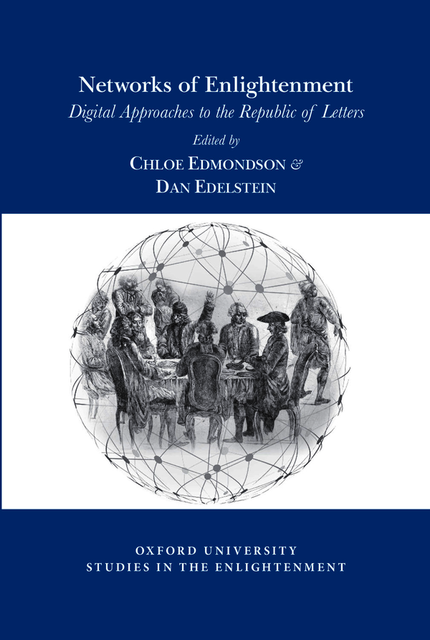Networks of Enlightenment
Digital Approaches to the Republic of Letters
This volume explores the centrality of social networks to the culture and identity of the Enlightenment. An individual in eighteenth-century Europe, no matter how intellectually engaged, simply could not take part in the Enlightenment on his or her own. Rather, one participated in one or more social networks, which informed the experiences and identities of their participants -- and thereby made up the social infrastructure of the Enlightenment. The essays in this volume offer fresh perspectives by drawing upon metadata captured from recently digitized correspondences of major Enlightenment figures and then mapping, conceptually as well as literally, the philosophes as "nodes" of complex and dynamic networks. These essays thereby explore with unprecedented detail the social, linguistic, geographic and institutional configurations of the Enlightenment.
This digital edition offers readers the full-text Introduction, Table of Contents and chapter summaries, as well as high-resolution versions of all figures and data visualizations which appear in the printed text.
About the digital edition of "Networks of Enlightenment"
This digital edition includes the complete Table of Contents, the full text of the Introduction, and summaries of each of the chapters. It also includes, in the Resource Collections below, high-resolution versions of all the figures, tables and images which appear in the book. The chapter summaries and figures, tables and illustrations are grouped into the three sections of the book.
Front Matter
Table of Contents
This table of contents indicates the full list of essays, and their respective authors, which appear in the book. Summaries of each chapter appear in this digital edition.
- This text has 0 annotations
- This text has 0 highlights
List of Tables and Figures
This list identifies the figures, tables and illustrations which appear in the book and includes links to high-resolution digital versions which appear only in this digital edition.
- This text has 0 annotations
- This text has 0 highlights
Chapter summariesChapters 1 - 9 of "Networks of Enlightenment"
Brief summaries of each of the body chapters which appear in full in the print edition of "Networks of Enlightenment".
- This text has 0 annotations
- This text has 0 highlights
Introduction
IntroductionHistorical network analysis and social groups in the Enlightenment
Chloe Summers Edmondson, Dan EdelsteinThis is the full text of the Introduction to the book, including associated figures and tables.
- This text has 0 annotations
- This text has 2 highlights
Part 1: Correspondence Networks
Chapter 1Voltaire’s correspondence network: questions of exploration and interpretation
Nicholas CronkSummary of chapter 1
- This text has 0 annotations
- This text has 0 highlights
Chapter 2Catherine the Great and the art of epistolary networking
Kelsey Rubin-Detlev, Andrew KahnSummary of chapter 2
- This text has 0 annotations
- This text has 0 highlights
Chapter 3‘He belonged to Europe’: Francesco Algarotti (1712-1764) and his European networks
Cheryl SmeallSummary of chapter 3
- This text has 0 annotations
- This text has 0 highlights
Chapter 4The networks and the reputation of an ambitious Republican of Letters: Jacques de Pérard (Paris, 1713-Stettin, 1766)
Pierre-Yves BeaurepaireSummary of chapter 4
- This text has 0 annotations
- This text has 0 highlights
Part 2 : Social Networks
Chapter 5Julie de Lespinasse and the ‘philosophical’ salon
Chloe Summers EdmondsonSummary of chapter 5
- This text has 0 annotations
- This text has 0 highlights
Chapter 6‘Un admirateur des philosophes modernes’: the networks of Swedish ambassador Gustav Philip Creutz in Paris, 1766-1783
Charlotta WolffSummary of chapter 6
- This text has 0 annotations
- This text has 0 highlights
Chapter 7Casanova’s French networks: transitioning from a backstage coterie to the beau monde
Maria Teodora ComsaSummary of chapter 7
- This text has 0 annotations
- This text has 0 highlights
Part 3: Knowledge Networks
- This text has 0 annotations
- This text has 0 highlights
Chapter 9The principles of meaning: networks of knowledge in Johnson’s Dictionary
Mark Algee-HewittSummary of chapter 9
- This text has 0 annotations
- This text has 0 highlights
Figures, Tables and Images
Resource Collections
Introduction
CollectionPart 1 : Correspondence Networks
CollectionPart 2 : Social Networks
CollectionPart 3 : Knowledge Networks
Collection
Single Resources
Image Image Figure 37- Verbs in part-of-speech network (details)
Image Figure 36- Nouns in part-of-speech network (detail)
Image Figure 34- Full network of words defined by Johnson in the Dictionary, connected by shared quotations and colored by community (modularity).
Image Figure 32- Citation frequency for the most cited authors in Johnson’s Dictionary.
Image Figure 26- Connections between eighteenth-century French academies
Image Figure 25- Example of simplified graphic representation of the social interactions in Creutz’s knowledge network
Image Figure 24- Type of intellectuals in Creutz’s knowledge networks. © Charlotta Wolff.
Image Figure 21- Lespinasse’s and d’Holbach’s salon networks and the overlap between them visualised as undirected networks in Gephi.
Image Figure 20- Demographics of d’Holbach’s network based on subset of attendees with a VIAF ID.
Metadata
- isbn9781786941961
- publisherLiverpool University Press
- publisher placeLiverpool
- restrictionsAll rights reserved
- rightsCopyright Liverpool University Press
- rights territoryWorld
- series number2019:06
- series titleOxford University Studies in the Enlightenment


